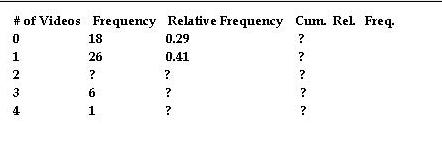Exam 1: Lessons 1 & 2
Name:_______________________
For questions 1 - 2, refer to the following:
A sample of 56 employees was taken to determine average pulse rate. The data is in the table below:
Pulse Rate – beats per minute |
Frequency (3 of employees) |
54 |
1 |
58 |
4 |
65 |
7 |
68 |
9 |
72 |
10 |
76 |
4 |
80 |
10 |
84 |
6 |
90 |
3 |
98 |
2 |
1. The mode(s) is/are:
A. 74 B. 72 and 80 C. 68 D. the average of 72 and 80
2. The variable is
A. the number of employees
B. all employees
C. the average pulse rate for the 56 employees
D. the pulse rate of one employee
Questions 3 – 5 use the following table:
The following table shows the ages of 50 senior citizens who attend a local senior center.
Age |
Frequency |
Relative Freq. |
Cum. Rel. Freq. |
| 56 |
9 |
0.18 |
|
| 63 |
8 |
|
|
| 68 |
18 |
0.36 |
|
| 73 |
8 |
0.16 |
|
| 80 |
5 |
0.10 |
|
| 88 |
2 |
0.04 |
1.000 |
3. Find the IQR.
A. 0.5 B. 17 C. 10 D. Not enough information
4. Which interval has the smallest percentage of data?
A. The interval 55.5 to 63.5.
B. The interval 63.5 to 68.5.
C. The interval 68.5 to 73.5.
D. The interval 73.5 to 88.5.
5. What percent of the ages are at most 68?
A. 36 B. 70 C. 30 D. 66
6. What can be said about a set of data when its standard deviation is zero?
A. If the data are ordered, they are very spread out from the mean.
B. All of the data appear with the same frequency.
C. If the data are ordered, they are very close to but different from the mean.
D. There is no mode.
7. For the following data, which measure of central tendency would be the LEAST useful?
Data: 4, 8, 11, 11, 11, 27, 27, 27, 27, 27, 1000
A. mean B. median C. mode D. standard deviation
Questions 8 – 10 refer to the following:
Sixty (60) college students were asked the number of units they are taking this quarter. The results are given in the following graph:
Relative Frequency
| 0.4 __ |
|
|
|
|
|
|
|
|
| |
| 0.3 __ |
|
|
|
|
|
|
|
|
| |
| 0.2 __ |
|
|
|
|
|
|
|
|
| |
| 0.1 __ |
|
|
|
|
|
|
|
|
| |
| |
|
|
|
|
|
|
|
|
| |
| |
10 |
11 |
12 |
13 |
14 |
15 |
16 |
Number of Units |
8. The number of responses that were “12” OR “13” is approximately
A. 18 B. 0.3 C. 25 D. Not enough information
9. The third quartile is:
A. 15 B. 14 C. 13 D. 12
10. The sample was taken by randomly selecting one student from the administration’s official list of students and then choosing every 100th. This is an example of what kind of sampling?

A. cluster B. systematic C. stratified D. convenience
11. How should you classify data from the following question: What is your blood pressure?
A. qualitative B. quantitative – discrete C. quantitative - continuous
12. How should you classify data from the following question: What is your favorite vacation place?
A. qualitative B. quantitative – discrete C. quantitative – continuous
13. A study is done to determine the average amount of tuition all San Jose State undergraduate students pay per semester. A sample of 100 undergraduate San Jose State students is taken by dividing the students into freshmen, sophomore, junior, and senior years and selecting 25 students from each. Each student is asked how much tuition he/she paid for the Spring 2002 semester. The type of sampling and the parameter are:
A. cluster and the average amount of tuition all San Jose State students paid Spring 2002.
B. stratified and the average amount of tuition the 100 San Jose State students paid Spring 2002.
C. cluster and the average amount of tuition the 100 San Jose State students paid Spring 2002.
D. stratified and the average amount of tuition all San Jose State students paid Spring 2002. |